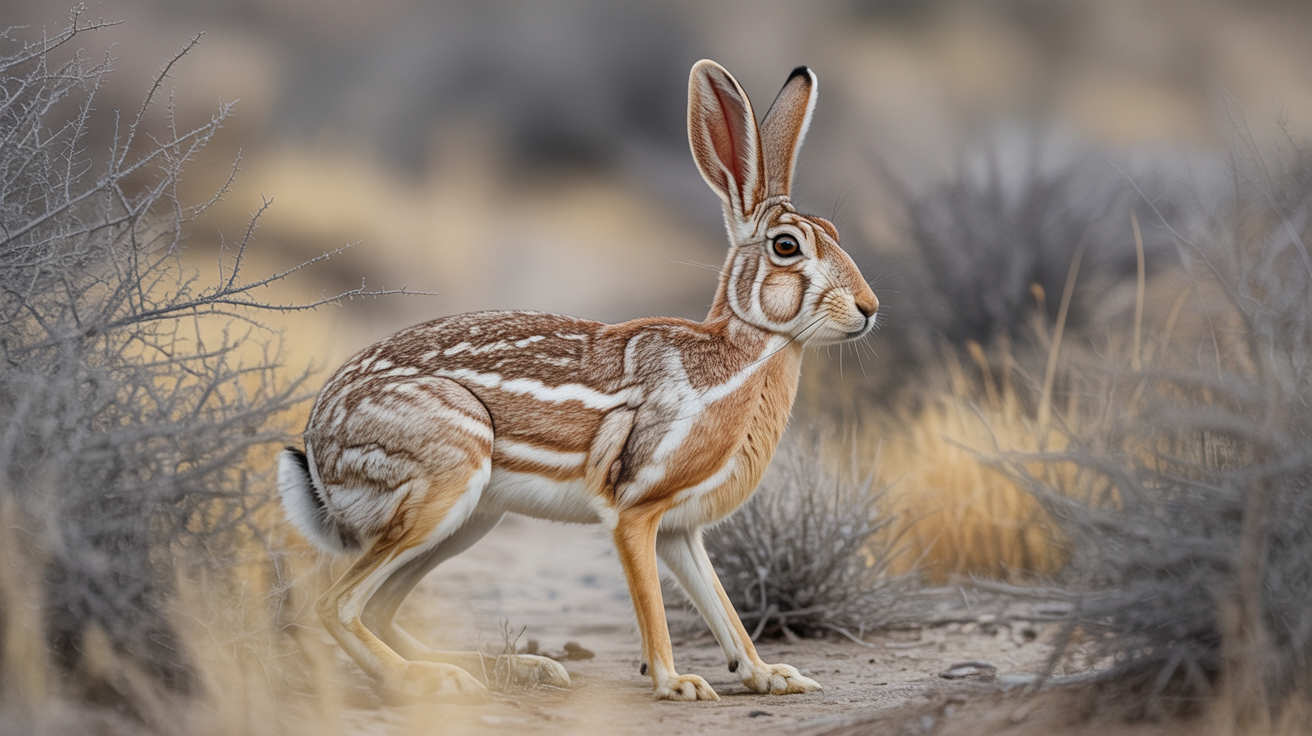
Antelope Jackrabbit
Lepus alleni

Meet the Antelope Jackrabbit
The Antelope Jackrabbit is a large hare native to the deserts and grasslands of northwestern Mexico and the southwestern United States. Recognized by its long, white-edged ears and strikingly white flanks, this jackrabbit is highly adapted to arid environments. It is known for its impressive running speed and agility, often leaping high into the air to evade predators. The Antelope Jackrabbit is primarily active during dusk and dawn and spends the hot daytime hours resting in shallow depressions it scrapes in the ground.
Classification
Mammal
Habitat
Arid grasslands and desert scrub
Diet
Herbivore
Lifespan
1-5 years
Conservation
Least Concern
Weight
3-6 kg
📖Fascinating Facts
Giant Ears
The Antelope Jackrabbit's ears can be up to 18 cm (7 inches) long, helping regulate their body temperature in extreme heat.
Fast Runner
They can reach speeds of up to 72 km/h (45 mph) and make high leaps to escape predators like coyotes and hawks.
Desert Dweller
Antelope Jackrabbits are specially adapted to survive in arid desert regions with little available water.
📋Detailed Description
The Antelope Jackrabbit (Lepus alleni) is among the largest North American hares, with adults typically weighing between 3.5 and 4.5 kg (7.7–9.9 lbs) and measuring 52–63 cm (20–25 in) in body length. Its most distinctive features include exceptionally long, black-tipped ears edged in white, and conspicuous white flanks and underparts that contrast with its grizzled grayish-brown dorsal fur. The hind legs are elongated and powerful, adapted for rapid acceleration and high leaps, enabling escape from predators. The skull is broad with a relatively flat profile, and the eyes are large, providing a wide field of vision crucial for detecting threats in open habitats. The pelage is dense and coarse, offering protection from both heat and abrasive desert vegetation. Antelope Jackrabbits are primarily crepuscular, being most active during dawn and dusk, and spend the heat of the day resting in shallow scrapes called 'forms' that they dig in shaded or vegetated areas. Solitary by nature, they exhibit minimal social interaction outside of the breeding season. Their diet consists mainly of grasses, forbs, and cacti, with seasonal variation depending on plant availability. They have a high tolerance for arid conditions, obtaining much of their water from succulent vegetation. Lifespan in the wild is typically 1–5 years, with predation and environmental stressors being the main causes of mortality.
💡 Did you know?
Despite their name, Antelope Jackrabbits are not closely related to antelopes; their name comes from the white flanks that resemble those of pronghorn antelopes.
🔬Research & Sources
Wikipedia Summary
The antelope jackrabbit, also known as Allen's hare, is a species of North American hare in the family Leporidae found in southern Arizona and northwestern Mexico. Considered the "handsomest" of the hares, it occupies dry desert areas and was one of the last of the North American mammals to be formally described.
Last Modified: 4/24/2025
🎭Behavior & Social Structure
Antelope Jackrabbits are solitary and highly territorial, with individuals maintaining overlapping home ranges that can span 10–40 hectares. They are primarily crepuscular, emerging at twilight to forage and remaining vigilant for predators such as coyotes, bobcats, raptors, and snakes. Their feeding behavior involves selective grazing on tender shoots, grasses, and occasionally browsing on shrubs and cacti, particularly during dry periods. They rely on acute hearing and vision to detect threats, often freezing motionless to avoid detection or launching into rapid, zigzagging sprints and high leaps when pursued. Social interactions are limited outside of the breeding season, though brief chases and displays may occur during courtship. Antelope Jackrabbits communicate through body postures, thumping their hind feet to signal alarm, and occasionally through soft vocalizations. They are known to use established runways and have a strong homing instinct, often returning to the same resting forms.
👶Reproduction & Life Cycle
Breeding in Lepus alleni occurs primarily from December through September, with peak activity in spring and early summer, coinciding with increased food availability. Males engage in competitive chases and boxing matches to gain access to receptive females. After mating, the gestation period lasts approximately 41–43 days. Females (does) give birth to litters of 1–5 precocial leverets, which are born fully furred and with eyes open, in shallow ground depressions concealed by vegetation. Unlike rabbits, jackrabbits do not construct elaborate nests. Maternal care is minimal; the female visits her young only briefly to nurse, reducing the risk of attracting predators. Leverets are weaned within two to three weeks and become independent shortly thereafter. Females may produce multiple litters per year, depending on environmental conditions.
🛡️Adaptations & Survival
The Antelope Jackrabbit exhibits several adaptations for desert survival. Its large ears serve as thermoregulatory structures, dissipating excess body heat through an extensive network of blood vessels. The pale coloration of its flanks and underparts reflects solar radiation, reducing heat absorption. Its long, powerful hind limbs enable rapid acceleration and high, bounding leaps—up to 3 meters (10 ft) vertically—to evade predators and navigate uneven terrain. The species has a low metabolic rate and can survive on minimal free water, deriving moisture from succulent plants and dew. Behavioral adaptations include crepuscular activity patterns to avoid daytime heat and the use of shaded forms for daytime rest. Its acute senses of hearing and vision are critical for predator detection in open landscapes.
🎨Cultural Significance
While not as prominent in folklore as some other North American lagomorphs, the Antelope Jackrabbit has been noted in regional indigenous cultures for its agility and elusive nature, sometimes symbolizing speed and alertness. It has occasionally been hunted for food and fur by local communities, though it is not a major game species. Its striking appearance and impressive leaping ability have made it a subject of interest for naturalists and wildlife enthusiasts.
🔬Recent Research & Discoveries
Recent research on Lepus alleni has focused on its phylogenetic relationships within the genus Lepus, revealing genetic divergence from other North American jackrabbits. Studies have also examined its thermoregulatory physiology, demonstrating the efficiency of ear-based heat dissipation. Ongoing ecological research investigates its role in desert grassland ecosystems, particularly its interactions with native vegetation and response to habitat fragmentation. Camera trap surveys and radio telemetry have improved understanding of its movement patterns, habitat preferences, and population dynamics. There is growing interest in the effects of climate change on its distribution and reproductive timing.
🎥Wildlife Videos

Harris's Hawks Hunt a Jackrabbit | The Desert Sea
About National Geographic Wild: National Geographic Wild is a place for all things animals and for animal-lovers alike. Take a ...
Nat Geo Animals

Ecology of the Antelope Jackrabbit in the Southwest
Ecology of the Antelope Jackrabbit in the Southwest as presented by Dave Brown at the Wildlife First Symposium on October 19th, ...
AZTWS

Antelope jackrabbits grooming themselves
The Antelope jackrabbit gets its name from John Asaph Allen, a past curator at the American Museum of Natural History's ...
Pachuco'sArt/The Desert Whisperer

Antelope jackrabbit having lunch
Pachuco'sArt/The Desert Whisperer

This is how antelope jackrabbits get their food!
Antelope jackrabbits are folivores (leaf-eaters), graminivores (grass-eaters) and succulent plant eaters (esp. cacti). They mainly ...
Pachuco'sArt/The Desert Whisperer

Antelope jackrabbits fighting
"Antelope jackrabbit males will fight by boxing. They stand on their hind feet, using their forelimbs to strike each other repeatedly ...
Pachuco'sArt/The Desert Whisperer
🌍Habitat Information
The Antelope Jackrabbit typically inhabits Arid grasslands and desert scrub environments. Antelope Jackrabbits have adapted to their environments with specialized features and behaviors.
Primary Habitat:
Arid grasslands and desert scrub
More detailed habitat information will be available soon.
🛡️Conservation Status
The Antelope Jackrabbit is currently classified as Least Concern. Conservation efforts are crucial for preserving this species for future generations.
Common Threats:
- 🏠Habitat loss and fragmentation
- 🌡️Climate change impacts
- 🎯Hunting and poaching
- 🏭Human-wildlife conflict
⚠️Threats & Conservation Challenges
Currently classified as Least Concern by the IUCN, the Antelope Jackrabbit faces localized threats from habitat loss due to agricultural expansion, urban development, and overgrazing by livestock, which can degrade native grasslands and reduce food availability. Road mortality and predation by introduced species (such as feral dogs) also pose risks. Climate change may exacerbate habitat aridification and alter plant communities, potentially impacting food resources. Despite these challenges, the species remains relatively widespread and adaptable, with stable populations in most of its range. Ongoing monitoring is recommended to detect future declines, particularly in areas experiencing rapid land-use change.
🔬Scientific Classification
Scientific Name
Lepus alleni
Classification Hierarchy
🔍 About Taxonomic Classification
Taxonomic classification is a hierarchical system used by scientists to classify and organize living organisms based on shared characteristics and evolutionary relationships.
The system moves from broad categories (Kingdom) to increasingly specific ones, with each animal's scientific name typically consisting of its Genus and species.
📝Community Notes
Share your observations and insights about the Antelope Jackrabbit with our community of wildlife enthusiasts.
Join Our Community
Sign in to share your observations and connect with fellow wildlife enthusiasts.
Sign In to ContributeNo community notes yet
Be the first to share your observations about the Antelope Jackrabbit!
Explore Antelope Jackrabbit
Select a tab above to learn more about this amazing animal.
📸Photo Gallery
No photos available for this animal yet.
🌟Discover More Wildlife
Continue your journey of discovery with more fascinating animals from our database
